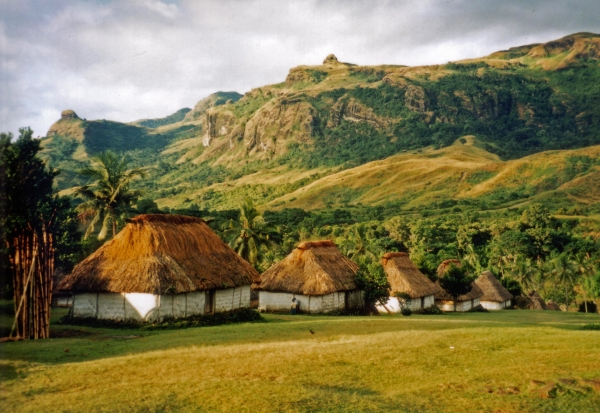Fiji’s most celebrated drink is a mouth-numbing root-based preparation that is drunk ceremonially to welcome visitors, seal business agreements and settle arguments

© BureNavala2 CC BY-SA 3.0 via Wikimedia
The Pacific nation of Fiji is known internationally for its palm-fringed beaches, its prowess on the rugby pitch and the rich history of its clans, which includes the long-discontinued practice of cannibalism. But what strikes many visitors to the country is the friendliness of its people, who are always quick to welcome newcomers into their midst.
Culturally, Fiji is split between indigenous Fijians and Indo-Fijians, whose ancestors were brought to the islands from India between 1879 and 1916 to work as indentured servants on sugar plantations. Traditional Fijian society is clan-based, with hereditary chiefs heading up its many villages where more than 300 dialects of the Fijian language are spoken. Villagers share the obligations and rewards of community life. They fish together, dividing the catch between them, build homes together, prepare feasts, and work together to maintain the village’s paths and shared spaces.
Anyone visiting a village must get prior permission and observe the correct etiquette on arrival. In Fijian culture, the head is a ‘sacred space’, seen by locals as a person’s connection to heaven. Therefore, hats are seldom worn, so as not to block this connection and it is seen as an insult to touch another person’s head. Bags carried on the shoulder are also viewed as an oddity, as ‘material assets’ should be carried lower down as an acknowledgement that everyone in the village is on the same level.
Food is still cooked traditionally for feasts in an earth oven, known as a lovo. A shallow hole is dug in the ground, in which a fire is lit. Large stones are put on top of the hot coals, with sticks of banana palm trunk laid over the hot rocks. The food – fish, chicken, cassava, breadfruit, vegetables and other fresh food – is wrapped tightly in banana or taro leaves and placed on the lattice formed by the sticks. More banana leaves are placed on top of the food and the whole thing is then covered in earth or sand to stop the steam escaping. The resulting slow-cooked food has a smokey flavour, popular with locals and visitors alike.
Kava, known as yaqona (pronounced ‘yangona’) in Fiji, is the national drink. Made from the pulverised root of a member of the pepper family, it is believed to have medicinal qualities and has a similar effect to alcohol in promoting a feeling of relaxation. It also causes the lips and tongue to become numb for a few minutes! But its importance in Fijian life goes far beyond its effect on the body – there is a great deal of ceremony and etiquette around the consumption of yaqona, which is drunk ritually when welcoming visitors, sealing business deals and on almost any other occasion that warrants an auspicious accompaniment, including naming boats, settling feuds and seeing villagers off on long journeys. It is also given as a sevusevu, a traditional gift offered to the host or chief by visitors arriving in a village.
The sharing of yaqona, usually drunk from a half coconut shell, is done in a specific sequence in any kind of formal ceremony. A server will carry the cup to the most senior guest, who must clap once before and after downing it. The rest of the gathering are then served in turn, according to strict hierarchy. Kava is drunk throughout the South Pacific and is the region’s traditional equivalent to alcohol. Legend has it that the origins of the ceremony come from Tonga, where the plant grew on the grave of a princess who had died of a broken heart.
The country’s other main community, that of Indo-Fijian, is made up of a variety of subcultures and religious backgrounds, but its people tend to be lumped together for administrative purposes. While many Indian traditions are upheld, others have been abandoned. For example, the caste system was not established in Fiji – other than in a ceremonial context – and, due to the smaller size of the community, Fiji Indians are more likely to have inter-religious marriages. Traditional kinship patterns found in Indian villages were also left behind, with people more likely to live in smaller nuclear family groups – though larger extended family living can be found in rural areas. Arranged marriages are still common, however, and Hindi remains a shared language across Indian communities – though it differs slightly to the Hindi spoken in India.
Not all Indo-Fijians arrived as indentured servants – Sikhs generally arrived later as traders and merchants. Today, their descendants own many of the shops and businesses in Fiji’s towns and cities. These communities tend to have much stronger attachments to India.
One element that sets indigenous Fijians apart from their Indian counterparts is land ownership. More than 80 per cent of land is owned by indigenous communities, under collective ownership of clans. Indians, therefore, have to lease land, which gives them less security, so they have been pressing for leases that last longer than the standard ten-year contracts. The majority of sugar cane is grown by Indian farmers, but almost all of this has to be farmed on leased land.
A tradition that is shared by both communities is that of firewalking. The actual ceremony differs between the two groups, but both culminate in the participants walking across either hot stones or embers, but remaining unscathed by their ordeal. Scientists have been curious as to how this is achieved without sustaining considerable burns and some have concluded that perhaps it is a mixture of the power of suggestion and a film of moisture on the skin acting as a protective layer. One thing is for certain, though: the opportunity to watch a firewalking ceremony is one of the many draws that keeps tourists coming back to Fiji year after year.





